The snow capped peaks surround us, and they still hold the names of god’s and goddesses. They are the vision that commands me to look up, captivating my heart. With whispered breath I pray.
Make me a mountain that does not question it’s existence, but rather stands tall enduring. Being seen by those who have embraced the journey. Seek not my secrets in a way to exploit them. Approach me with the eyes of innocence climb high upon me. Fear not the precipice that which you find yourself know that my mysteries will always be a friend to thee. Within my appetite reflections, still and deep, clarity and passion, the source of life.

I went to Peru to raft through the Grand Canyon of South America, on the threatened and largest free flowing river on the continent, the Rio Marañon. I was in for a big surprise, this was no walk in the park, this river was like none other I’ve ever seen.
In 2010 the Rio Marañon was declared the “energy artery” of South America, by then President Alan Garcia, after signing a pact with the Brazilian President to provide thousands of Mega Watts of power for export, he stated that damming the river was of “national interest.” There are more than a dozen dams being proposed and they would make the river a series of stagnant ponds that stair step down the length of the upper canyon, drowning out villages, small subsistence farms, and areas of natural wonder. Displacing 145,000 people who live along the river. The Rio Marañon is arguably the primary source of the Rio Amazona. The Tributaries in the Amazon Basin are delivering nutrients to the worlds largest set of lungs, our greatest resource in the fight against greenhouse gases. This land holds a delicate balance that has evolved over billions of years. One way to understand what is being wagered in this sanctioned act of terrorism, damming rivers, is to bear witness. We’ve decided to follow a drop of water to the Rio Marañon, tracing it’s course as it lands on the earth, we begin in the Andes, north of Lima in the Huayhuash mountains. The worlds highest tropical range, and yes there are glaciers, at least for now.
Peru has 11 of the worlds 18 eco-regions within its’s borders. It contains 16 percent of the worlds bio-diversity and just 1% of the worlds landmass. Simply put it is an amazing place. We arrived in Lima and the next morning made our way north along the coast through arid dry land dunes. Turning east we begin our climb to Huaraz, a modern city of 120,000 inhabitants living at 10,031 feet in elevation.
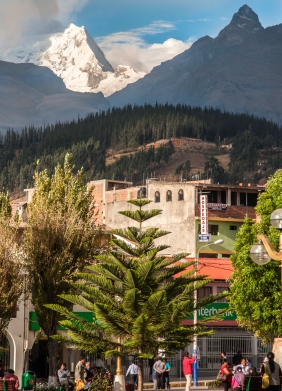
Everywhere you looked it is possible to catch a glimpse of glacier covered peaks that have lured international climbers for nearly a century. The city has a long history that predates the Inca empire. In fact in the Guitarrero cave which was discovered along side of the Santa River held the remains of a man and other artifacts that were carbon dated at 10,610BCE. Every inch of mountainside is cultivated. The patchwork of fields, containing potatoes, corn and beans. These cultivates are believed to have originated on these fertile slopes. What a contribution the people and land of Peru have made to the rest of the world. Nearly every culture, has these staples in their diet.
It’s a Monday and we hired a taxi to take us to Willkawayin, a highly regarded site for the Wari culture (500-1000A.D.) We arrived only to discover that it was closed, so we decided to continue on the road by foot in order to gain a vista of the surrounding valley and to get a bit of physical conditioning in before we made our trek to Laguna 69. Willkawayin by the way, means the divine or sacred house of the Great Grandchild, this house resides at 11,200 feet and we are feeling the elevation. There was a mother pig resting as the piglets take time to eat. A woman crossed the road in front of me, brilliantly dressed and she smiles and shouts out a warm welcome, I get the feeling they throughly love the land. These farmers are carrying on in a harmonious way of life that has been practiced for thousands of years. Clearly they are winning the endurance race.


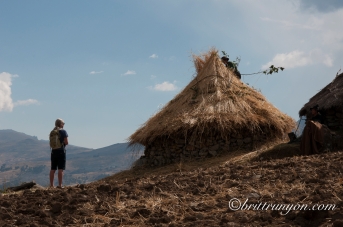 When we reached our vista point I saw a couple of men working on a thatched roof of a small stone house. These houses were of the same design that we will see later in Kuelap, made by the Chachapoya people nearly 1500 years ago. I called out a greeting, he replied “Tiene agua?” Do you have water?
When we reached our vista point I saw a couple of men working on a thatched roof of a small stone house. These houses were of the same design that we will see later in Kuelap, made by the Chachapoya people nearly 1500 years ago. I called out a greeting, he replied “Tiene agua?” Do you have water?
The majority of people that we met in the rural areas carry their water. They rely on springs and rivers to supply their water for their fields, cooking, bathing and washing. What if the very act of carrying water made it sacred. A river in it’s free state is doing a job that is far more important than providing power for mining, or diluting toxic waste. It provides life to all beings, to the plants and the very land that supports us. Our life is but a blink in the eye of the earth and with that reality each step we take is a gift. We were born in this world not deserving of its greatness but completely supported by it. We have an obligation to know what luck and good fortune are.

There are six of us, Kathy Hammerlee, Steve Miller, Britt Runyon and myself. We are affiliated through a small and tenacious rafting company New Wave Rafting Company which, operates on the Rio Grande and Chama River of northern New Mexico,that Kathy and Steve started in 1980. Britt Runyon arrived on the scene shortly after the conception of New Wave, he is the operations manager and official photographer. I am the new comer to the group having started my training as a guide only a decade before.
Felipe Chauca Torre and Don Juan with Peru Adventure Extreme, a outdoor adventure guiding service, are taking care of the logistics and much more. It’s obvious that they are at home in these peaks. Don Juan wears a winter coat adorned with many patches of different expeditions he has been on. Felipe is a local from Santa Cruz, a small farming village just outside of Huaraz near the Lake Willacocha and has been trained as a professional guide through the Andes Mountaineering School in Huaraz. They both speak Quechua, in addition to spanish and are native to this Ancash region.

We left Huaraz the day before the harvest full moon, traveling north on the highway that parallels the Rio Santa to a small town of Yungay. It is there that we turn eastward and begin our climb to the Huascaran National Park. The elevational range of Huascaran National Park goes from 11,483 feet to 22,205 feet with the maximum elevation corresponding to Huascaran mountain of Peru.
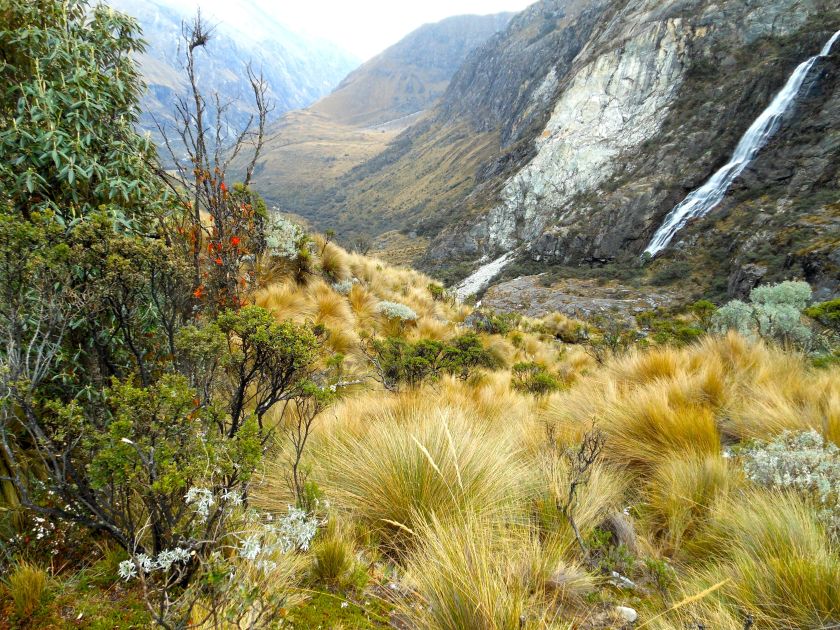
The eco-culture of the valley is known as a Puna grassland and is really a lovely mix of medium to tall grasses. So many textures something that always teases me as if I could lay down and slumber in it’s lushness. Not with out warning for there are a lot of cactuses at this elevation as well as, pin cushion plants.


Snow capped peaks surround us creating a giant bowl and at one end of the bowl is a very large waterfall. It is a cascade that is more than a 1000 feet high and can be heard as white noise of the valley. Each step draws me nearer to the base of the glaciers. These living towers are communing with the clouds. Moving pictures, one that captures the very essence of alchemy.
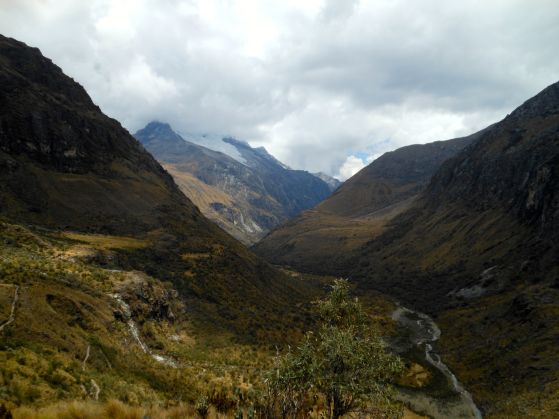
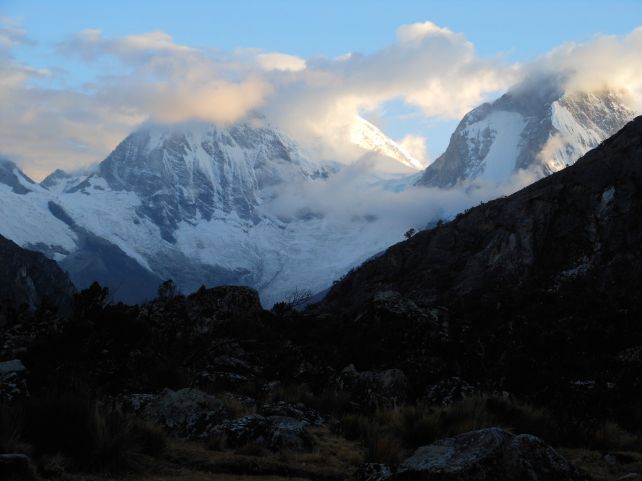
Don Juan is sitting and I join him. We have a audience they are a bunch of rogue cows, handsome but not the sort of wild life I enjoy. His smile gets a bit wider and I see he has a sling shot in his hand as the cows advance he does not hesitate to give them a warning. “Son libres?” I ask. “ Si” he says. They have escaped their pastoral life.
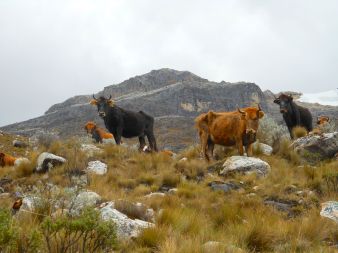
Only 2 degrees from the equator, yet the temperature is brisk, I am wearing a down jacket. The length of a day does not change near the equator. Later on while in the Jungle I share the fact that where a friend of mine lives in Alaska they have three months without sun and three months where it hardly sets and they stare at me with wide eye disbelief, I am having one of those moments.
We reach the plateau, 14,508 feet, just below the lake and set up camp. The large canvas tent is the kitchen tent and Don Juan’s sleeping quarters. Felipe informs us tea will be served after we our tents are set up. The makeshift table is adorned with a colorful textile, the kind that the woman traditionally wear around Huaraz. The five cups are filled with coca tea, it is said to help with acclimation, a cultural plant that is revered for it’s medicinal qualities. This seems a bit like a dream.
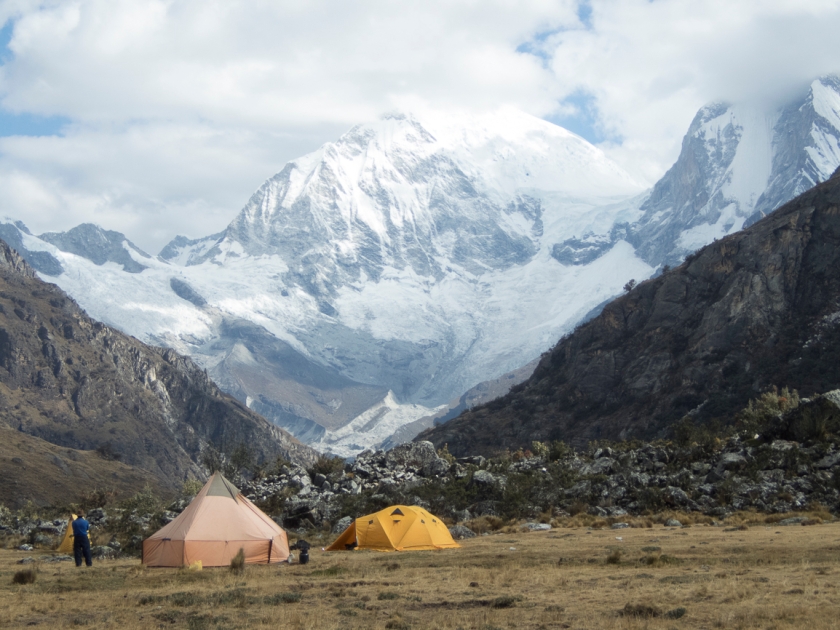
The next morning we make our way up to Laguna 69, the name that the park service has given this lake. The view is captivating. On the far end of the lake is a waterfall that comes from the glacier. An avalanche breaks and we hear the cascade of ice and rock. We are witnessing the movements of mountains it’s enough to make you whisper.


I spent the entire day just sitting on the shore of this lake, it was precious. Before I knew it the time had come to return to our camp. Along the way we saw a cute little high altitude dweller that resembles a rabbit named a Viscacha.
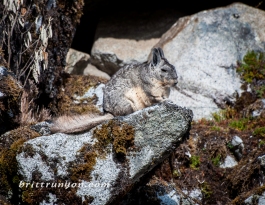
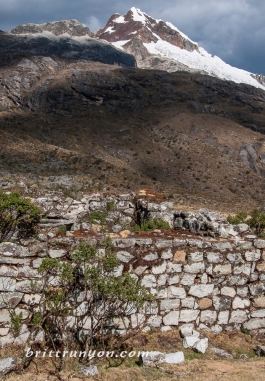
That night at camp the clouds cleared revealing the full moon in her splendor. A rare sighting to see the star adorned peaks at night and our guide Felipe was not going to let us leave without enjoying it. He cajoled Kathy and I to take a moonlight stroll with him if nothing else just to breath in the light air that efficiently supports our every function. A beautiful memory and opportunity to see water in the making.
My future posts will include more information on the Rio Marañon.
Special thanks to Britt Runyon Photography

Beautifully done, CJ. What an amazing journey. I learned a lot from this essay!
LikeLiked by 1 person
Thank you Krishnan.
LikeLike
Wonderful! Thanks
LikeLiked by 1 person
Spectacular!
LikeLiked by 1 person